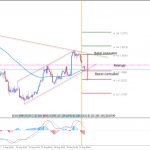Yesterday we noted the massive market cap inflation and then stupendous collapse of the Delirious Dozen of 2000. The latter included Microsoft (MSFT), Cisco (CSCO), Dell (DVMT), Intel (INTC), GE (GE), Yahoo (YHOO), AIG (AIG) and Juniper Networks (JNPR)—plus four others which didn’t survive (Lucent, WorldCom, Global Crossing and Nortel).
Together they represented a classic blow-off top in the context of a central bank corrupted stock market. When the bubble neared its asymptote in early 2000, the $3.8 trillion of market cap represented by these 12 names was capturing most of the oxygen left in the casino. That is, the buying frenzy had narrowed to a smaller and smaller group of momo names.
That severe concentration pattern was starkly evident during the 40 months between Greenspan’s December 1996 “irrational exuberance” speech and April 2000 (when he told the Senate no bubble was detectable). In that interval, the group’s combined market cap soared from $600 billion to $3.8 trillion.
That represented, in turn, a virtually impossible 75% per annum growth rate for what were already mega-cap stocks. As it happened, in fact, $2.7 trillion or 71% of the group’s bubble peak market cap vanished during the next two years.
What we didn’t mention yesterday, however, is that this bubble top intumescence never really came back. In fact, the market cap of the eight surviving companies—all of which have continued to grow—-today stands at just $1.3 trillion or 34% of the 17-years ago peak.
Needless to say, that’s because the market no longer affords the Delirious Dozen of 2000 valuation multiples that are even remotely in the same bubblicious zip code.
Thus, the eight survivors posted combined net income of $52.3 billion during the LTM period ending in September 2017. On the far side of the 1999-2000 tech bubble, therefore, current earnings turn out to be worth 25X—not the 75X recorded back then.
We revisit the rise and fall of these turn of the century high flyers because we believe the same process of market narrowing into a diminishing number of momo names is exactly what is happening again as we reach the asymptote of this latest and greatest central bank fueled bubble.














Leave A Comment